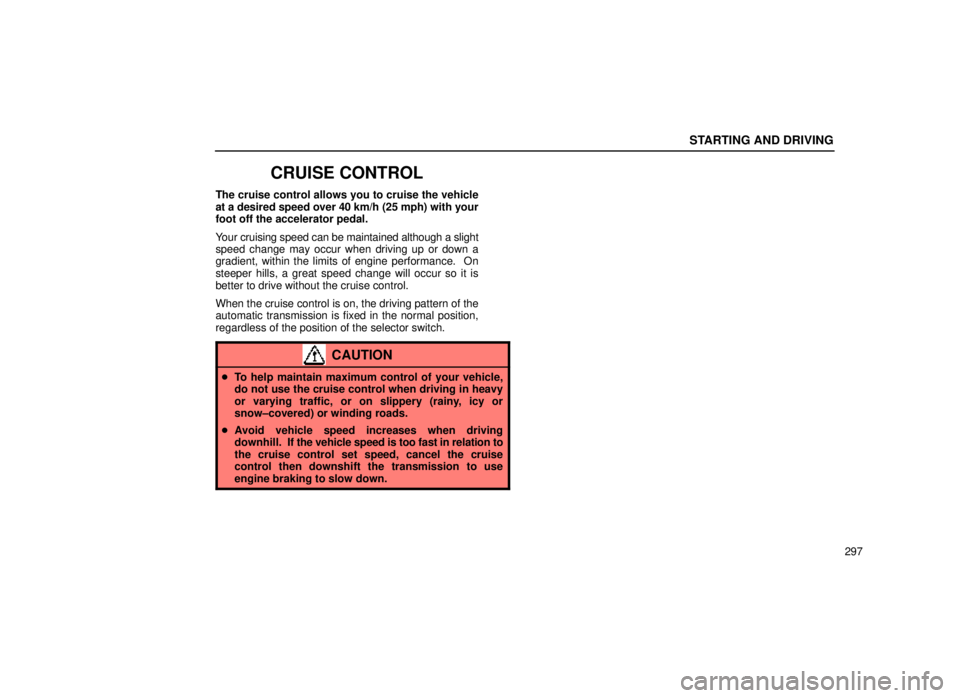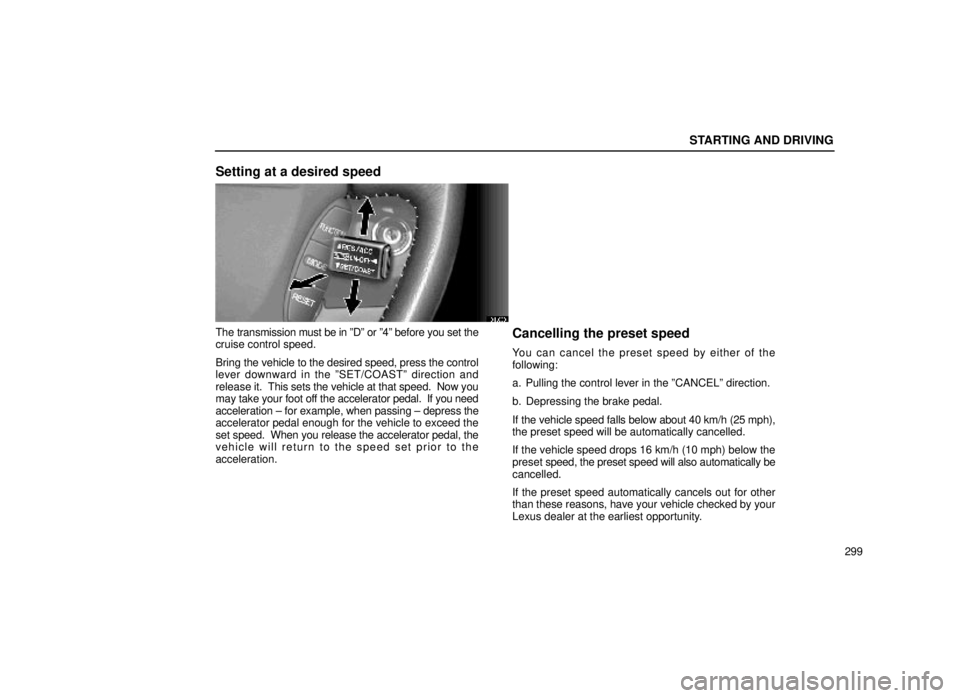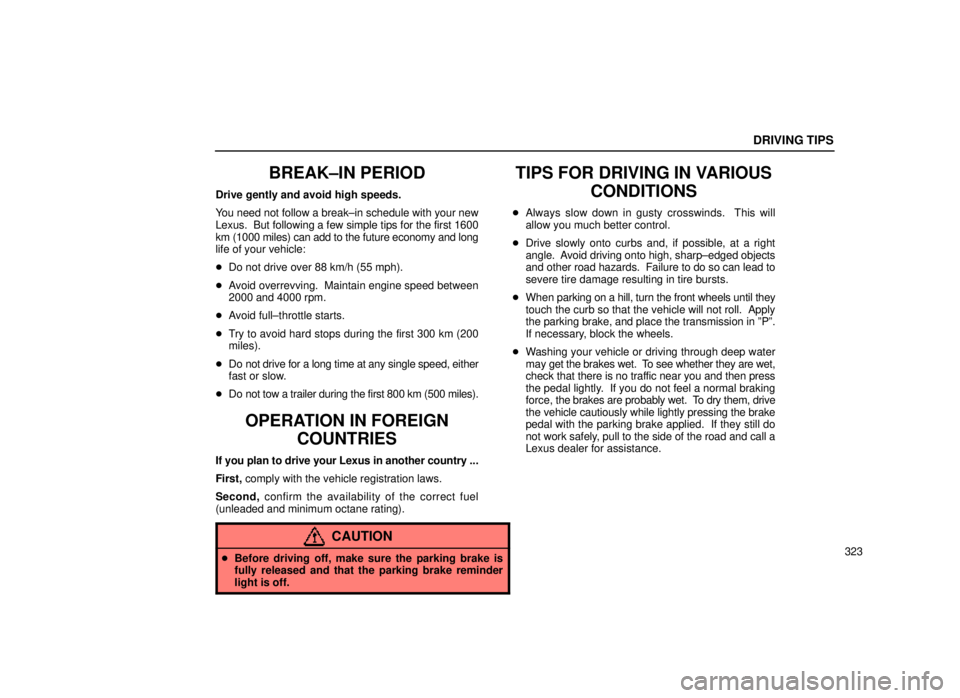Page 309 of 495
STARTING AND DRIVING
293
(f) Good driving practice
�If the transmission repeatedly upshifts and
downshifts between the fourth and overdrive gears
when climbing a gentle slope, shift the selector lever
to the º4º position. Be sure to shift the selector lever
to the ºDº position after climbing the slope.
� When towing a trailer, in order to maintain efficient
engine braking and electrical charging performance,
do not use overdrive. The selector lever must be in
the º4º position.
CAUTION
Always keep your foot on the brake pedal while stopped
with the engine running. This prevents the vehicle from
creeping.
NOTICE
Do not hold the vehicle on an upgrade with the accelerator pedal. This can cause thetransmission to overheat. Always use the brakepedal or parking brake.
(g) Rocking your vehicle if stuck
Page 310 of 495

STARTING AND DRIVING
294
CAUTION
If your vehicle becomes stuck in snow, mud, sand, etc.,
then you may attempt to rock the vehicle free by moving
it forward and backward. Do not attempt this procedure
if people or objects are anywhere near the vehicle.
During the rocking operation the vehicle may suddenly
move forward or back as it becomes un±stuck, causing
injury or damage to nearby people or objects.
NOTICE
If you rock your vehicle, observe the following
precautions to prevent damage to thetransmission and other parts.
�Do not depress the accelerator pedal whileshifting the selector lever or before thetransmission is completely shifted to forwardor reverse gear.
�Do not race the engine and avoid spinning thewheels.
�If your vehicle remains stuck after rocking thevehicle several times, consider other wayssuch as towing.
(h) If you cannot shift the selector lever
If you cannot shift the selector lever even though the
brake pedal is depressed, use the shift lock override
button. For instructions, see ºIf you cannot shift
automatic transmission selector leverº on page 375.
Page 312 of 495
STARTING AND DRIVING
296In the power mode, the ºECT PWRº light in the
instrument cluster is on and the transmission is shifted
up at higher vehicle speeds and shifted down more
responsively than in the normal mode.
To return to the normal mode, push the driving pattern
selector switch lightly on the ºSNOWº side.
Snow mode: For slippery road surfaces such as in
snow. In this mode, the spinning of the rear wheels is
controlled appropriately.
When
you push the driving pattern selector switch on the
ºSNOWº side, the snow mode is turned on and the ºECT
SNOWº light in the instrument cluster comes on.
To return to the normal mode, push the driving pattern
selector switch on the ºSNOWº side again.
When you turn the ignition switch off in the snow mode,
the mode automatically changes to the normal mode.
Page 313 of 495

STARTING AND DRIVING
297
CRUISE CONTROL
The cruise control allows you to cruise the vehicle
at a desired speed over 40 km/h (25 mph) with your
foot off the accelerator pedal.
Your cruising speed can be maintained although a slight
speed change may occur when driving up or down a
gradient, within the limits of engine performance. On
steeper hills, a great speed change will occur so it is
better to drive without the cruise control.
When the cruise control is on, the driving pattern of the
automatic transmission is fixed in the normal position,
regardless of the position of the selector switch.
CAUTION
�To help maintain maximum control of your vehicle,
do not use the cruise control when driving in heavy
or varying traffic, or on slippery (rainy, icy or
snow±covered) or winding roads.
� Avoid vehicle speed increases when driving
downhill. If the vehicle speed is too fast in relation to
the cruise control set speed, cancel the cruise
control then downshift the transmission to use
engine braking to slow down.
Page 315 of 495

STARTING AND DRIVING
299
Setting at a desired speed
31L068
The transmission must be in ºDº or º4º before you set the
cruise control speed.
Bring the vehicle to the desired speed, press the control
lever downward in the ºSET/COASTº direction and
release it. This sets the vehicle at that speed. Now you
may take your foot off the accelerator pedal. If you need
acceleration ± for example, when passing ± depress the
accelerator pedal enough for the vehicle to exceed the
set speed. When you release the accelerator pedal, the
vehicle will return to the speed set prior to the
acceleration.Cancelling the preset speed
You can cancel the preset speed by either of the
following:
a. Pulling the control lever in the ºCANCELº direction.
b. Depressing the brake pedal.
If the vehicle speed falls below about 40 km/h (25 mph),
the preset speed will be automatically cancelled.
If the vehicle speed drops 16 km/h (10 mph) below the
preset speed, the preset speed will also automatically be
cancelled.
If the preset speed automatically cancels out for other
than these reasons, have your vehicle checked by your
Lexus dealer at the earliest opportunity.
Page 316 of 495

STARTING AND DRIVING
300
Resetting to a faster speed
Press the control lever upward in the ºRES/ACCº
direction and hold it. Release the lever when the desired
speed is attained. While the lever is held upward, the
vehicle will gradually gain speed.
When the difference between the actual vehicle speed
and the set speed is less than 5 km/h (3 mph), the set
speed can be increased 1.6 km/h (1 mph) each time by
pressing the control lever upward in the ºRES/ACCº
direction quickly within 0.6 seconds.
However, a quicker way to reset is to accelerate the
vehicle and then press the control lever downward in the
ºSET/COASTº direction.
Resetting to a slower speed
Press the control lever downward in the ºSET/COASTº
direction and hold it. Release the lever when the desired
speed is attained. While the lever is held downward, the
vehicle speed will gradually decrease.
When the difference between the actual vehicle speed
and the set speed is less than 5 km/h (3 mph), the set
speed can be lowered 1.6 km/h (1 mph) each time by
pressing the control lever downward in the
ºSET/COASTº direction quickly within 0.6 seconds.
However, a quicker way to reset is to depress the brake
pedal and then press the control lever downward in the
ºSET/COASTº direction.
Even if you downshift the transmission from the ºDº
position to º4º with the cruise control on, engine braking
will not be applied because the cruise control is not
cancelled. To decrease the vehicle speed, reset to a
slower speed with the cruise control lever or depress the
brake pedal. If you use the brake pedal, cruise control
is cancelled.
Page 327 of 495

STARTING AND DRIVING
311
After the battery terminals are disconnected, an initial
adjustment should be made. At this time, the reminder
light
comes on and the warning message appears in the
multi information display.
Make an initial adjustment in the following ways:
1. Apply the parking brake and put the transmission in
ºPº.
2. Connect the battery terminals.
3. Turn the ignition switch on. At this time, the ºVSC
OFFº indicator light comes on and then about 6 seconds
later, the reminder light comes on and the ºCHECK VSCº
warning message appears in the multi information
display.
4. The warning message and the ºVSC OFFº indicator
light go out about 15 seconds after the ignition switch is
turned on. If the vehicle is shaken after the ignition
switch is t urned to ºONº, it may take longer to go out the
warning message.
If the warning message does not go out about 1 minute
after you turn the ignition switch on, turn it off and then
on again.
If the vehicle is on the moving object like a ship or
turntable, an accurate adjustment cannot be made.
Move the vehicle on the ground (or the part not causing
vibrations to the vehicle) and make an adjustment from
step 1.
Page 339 of 495

DRIVING TIPS
323
BREAK±IN PERIOD
Drive gently and avoid high speeds.
You need not follow a break±in schedule with your new
Lexus. But following a few simple tips for the first 1600
km (1000 miles) can add to the future economy and long
life of your vehicle:
�Do not drive over 88 km/h (55 mph).
� Avoid overrevving. Maintain engine speed between
2000 and 4000 rpm.
� Avoid full±throttle starts.
� Try to avoid hard stops during the first 300 km (200
miles).
� Do not drive for a long time at any single speed, either
fast or slow.
� Do not tow a trailer during the first 800 km (500 miles).
OPERATION IN FOREIGN
COUNTRIES
If you plan to drive your Lexus in another country ...
First, comply with the vehicle registration laws.
Second, confirm the availability of the correct fuel
(unleaded and minimum octane rating).
TIPS FOR DRIVING IN VARIOUS CONDITIONS
�Always slow down in gusty crosswinds. This will
allow you much better control.
� Drive slowly onto curbs and, if possible, at a right
angle. Avoid driving onto high, sharp±edged objects
and other road hazards. Failure to do so can lead to
severe tire damage resulting in tire bursts.
� When parking on a hill, turn the front wheels until they
touch the curb so that the vehicle will not roll. Apply
the parking brake, and place the transmission in ºPº.
If necessary, block the wheels.
� Washing your vehicle or driving through deep water
may get the brakes wet. To see whether they are wet,
check that there is no traffic near you and then press
the pedal lightly. If you do not feel a normal braking
force, the brakes are probably wet. To dry them, drive
the vehicle cautiously while lightly pressing the brake
pedal with the parking brake applied. If they still do
not work safely, pull to the side of the road and call a
Lexus dealer for assistance.
CAUTION
� Before driving off, make sure the parking brake is
fully released and that the parking brake reminder
light is off.